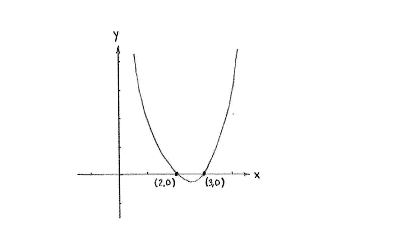Solution 2.3:9b
From Förberedande kurs i matematik 1
m (Robot: Automated text replacement (-[[Bild: +[[Image:)) |
m |
||
| (2 intermediate revisions not shown.) | |||
| Line 1: | Line 1: | ||
| - | {{ | + | The points of intersection are those points on the curve which also lie on the ''x''-axis, i.e. they are those points which satisfy both the equation of the curve |
| - | < | + | <math>y=x^{2}-5x+6</math> and the equation of the ''x''-axis <math>y=0</math>, |
| - | {{ | + | |
| - | {{ | + | {{Displayed math||<math>\left\{\begin{align} |
| - | <center> [[Image:2_3_9b-2(2).gif]] </center> | + | y&=x^{2}-5x+6\,,\\ |
| - | + | y&=0\,\textrm{.} | |
| + | \end{align}\right.</math>}} | ||
| + | |||
| + | This system of equations gives directly that <math>y=0</math> and that <math>x</math> must satisfy the quadratic equation <math>x^{2}-5x+6=0\,</math>. By completing the square, we obtain that the left-hand side is | ||
| + | |||
| + | {{Displayed math||<math>\begin{align} | ||
| + | x^{2} - 5x + 6 &= \Bigl(x-\frac{5}{2}\Bigr)^{2} - \Bigl(\frac{5}{2}\Bigr)^{2} + 6\\[5pt] | ||
| + | &= \Bigl(x-\frac{5}{2}\Bigr)^{2} - \frac{25}{4} + \frac{24}{4}\\[5pt] | ||
| + | &= \Bigl(x-\frac{5}{2}\Bigr)^{2} - \frac{1}{4} | ||
| + | \end{align}</math>}} | ||
| + | |||
| + | and this gives that the equation has solutions <math>x=\tfrac{5}{2}\pm\tfrac{1}{2}</math>, i.e. <math>x=\tfrac{5}{2}-\tfrac{1}{2}=\tfrac{4}{2}=2</math> and <math>x=\tfrac{5}{2}+\tfrac{1}{2}=\tfrac{6}{2}=3</math>. | ||
| + | |||
| + | The intersection points are therefore (2,0) and (3,0). | ||
| + | |||
| + | |||
| + | <center>[[Image:2_3_9b-2(2).gif]]</center> | ||
Current revision
The points of intersection are those points on the curve which also lie on the x-axis, i.e. they are those points which satisfy both the equation of the curve \displaystyle y=x^{2}-5x+6 and the equation of the x-axis \displaystyle y=0,
| \displaystyle \left\{\begin{align}
y&=x^{2}-5x+6\,,\\ y&=0\,\textrm{.} \end{align}\right. |
This system of equations gives directly that \displaystyle y=0 and that \displaystyle x must satisfy the quadratic equation \displaystyle x^{2}-5x+6=0\,. By completing the square, we obtain that the left-hand side is
| \displaystyle \begin{align}
x^{2} - 5x + 6 &= \Bigl(x-\frac{5}{2}\Bigr)^{2} - \Bigl(\frac{5}{2}\Bigr)^{2} + 6\\[5pt] &= \Bigl(x-\frac{5}{2}\Bigr)^{2} - \frac{25}{4} + \frac{24}{4}\\[5pt] &= \Bigl(x-\frac{5}{2}\Bigr)^{2} - \frac{1}{4} \end{align} |
and this gives that the equation has solutions \displaystyle x=\tfrac{5}{2}\pm\tfrac{1}{2}, i.e. \displaystyle x=\tfrac{5}{2}-\tfrac{1}{2}=\tfrac{4}{2}=2 and \displaystyle x=\tfrac{5}{2}+\tfrac{1}{2}=\tfrac{6}{2}=3.
The intersection points are therefore (2,0) and (3,0).

